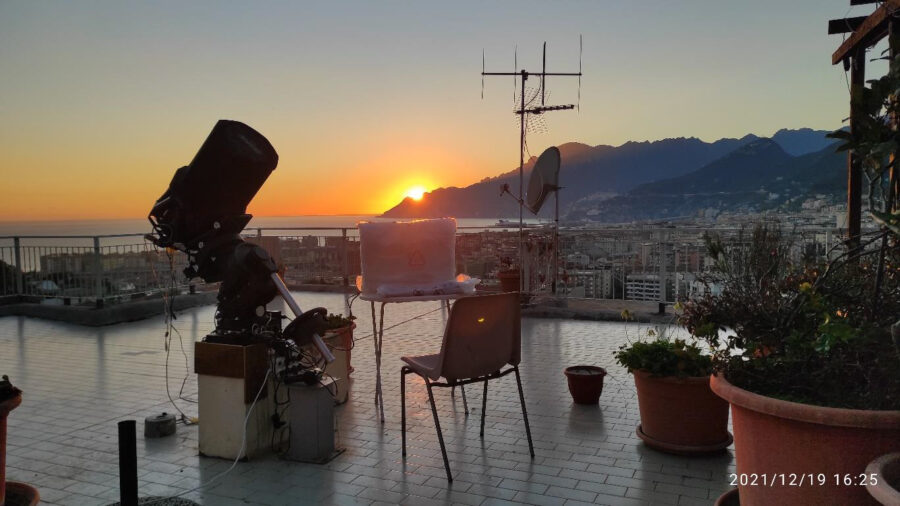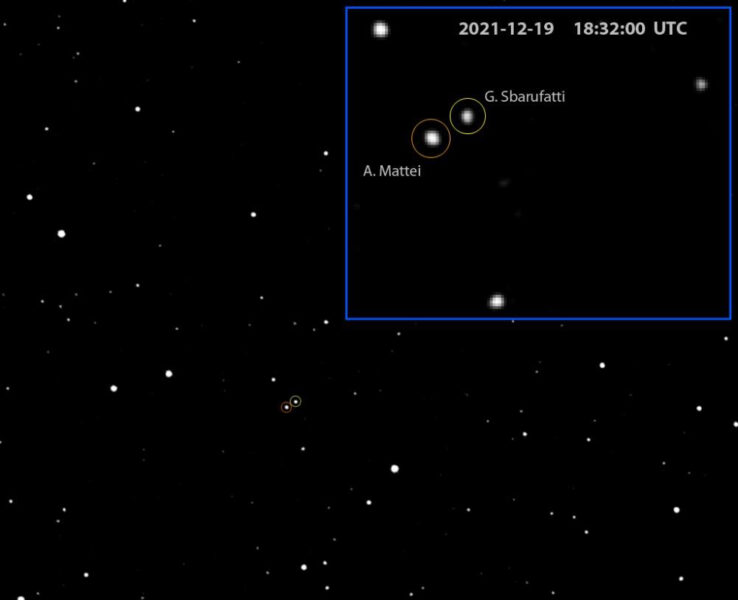On the afternoon of December 19, 2021, our team of amateur astronomers in two cities in Italy, Cremona and Salerno, observed the close pass of near-Earth asteroid 163899 (2003 SD220). Our observations allowed us to calculate its distance by the parallax method.
the parallax of an object is its apparent shift depending on the angle from which we view it, in the same way that a finger held close to your eyes seems to move depending on whether you look at it with your left or right eye.
Our team has undertaken similar projects in the past. We enjoy coordinating work over hundreds of kilometres, obtaining the highest precision from our amateur equipment and braving the cold of an evening close to the winter solstice.
To calculate the parallax, we must first calculate the OK, or the distance between the two shooting locations according to their latitude and longitude. Our cities are relatively close to each other, 636.74 kilometers, but far enough apart to allow a parallax calculation.
Beginning around 5:30 p.m. on December 19, we connected via audio and video with Cristian Gambarotti, who helped coordinate the effort. From Cremona, Gerardo Sbarufatti captured the view through a refractor with a focal length of 800mm, while from Salerno, Andrea Mattei used an ATIK 383L CCD attached to a 10-inch Ritchey-Chrétien with a focal length of 2000mm .
Taking into account the rotation of our own planet, which makes the sky appear to rotate at 12.54 arcseconds per minute, and the theoretical CCD resolution of 1.11 arcseconds per pixel, we originally thought to take a 5.3 second exposure. However, given atmospheric turbulence, light pollution and the asteroid fading to 14th magnitude, we felt it necessary to expose for at least 8 seconds to get an acceptable signal. Synchronizing our computers with precision, we each took several shots at 30 second intervals.

Then, after acquiring the images, we synchronized them to the time they were taken and obtained the exact position of the asteroid in the sky. Then from that astrometry, we calculated the parallax of the asteroid as it passed near Earth, an offset of 23.5426 arcseconds. The superposition of images taken at different locations at the same time highlights the apparent change in position of the asteroid:

Then, using simple geometry, we converted the parallax to an exact distance: 5578.700km
We compared this result to the ephemerides given by JPL’s Horizons Ephemeris Servicefinding a difference of only 68,615 km, and therefore an error of only 1.22%.
The experiment highlighted the limits of our equipment: Even using precise astrometric measurements, made meticulously and with low residuals, we nevertheless found that an error of only one hundredth of a second of arc on the position of the asteroid in the sky could shift the distance measurement by about 900 km.
Nevertheless, the measurements are relatively precise. Performing the same types of measurements on subsequent pairs of images, we might even notice the gradually increasing distance to the asteroid as it moves away from Earth.
Andrea Mattei is the president of the association Astrofili Salernitani. Mathematician and programmer passionate about astronomy for more than 40 years, he mainly deals with astrometry and photometry. Gerardo Sbarufattiastrophotographer with over 30 years of experience, is a member of the Astrofili Cremonesi group. Christian Gambarotti is Associate Professor of Chemistry at the Politecnico di Milano and President of the Astrofili Cremonesi Group.
Advertising
 Universo Viviente
Universo Viviente



